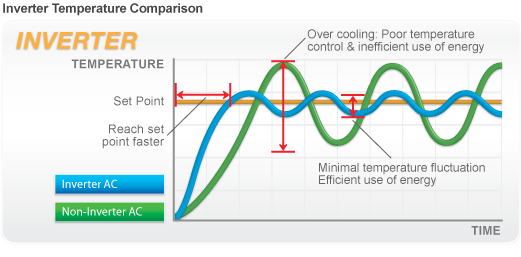What is non-inverter air conditioner
Compressors in non-inverter air-conditioners can only be operated at single speed, ON (100%) or Off (0%). Therefore, when you turn on the non-inverter air conditioner, you feel that the cold air is blowing and the normal air is blowing at the next moment. This is not desirable when it reaches a comfortable level. Whenever a compressor starts, it consumes six times as much electricity as its operating current. This frequent start / stop results in high power consumption, shortening compressor life and high noise levels.
Initially, a non-inverter air conditioner had only one compressor to support some indoor fan coil units. This is very inefficient, because the compressor will always run at full capacity no matter how many rooms are used. Whether you open 1 room or 3 rooms, the power consumption is always the same.
Technologically advanced non-inverter air conditioner started to introduce 2 compressors on the market instead of one. For example, one system 3 will have one 8500Btu compressor connected to one room (main room) and another 12000Btu compressor connected to two rooms. So when the main room is open, it can only run one compressor. If the other two rooms are open, the cooling power will be distributed to up to 6000 Btu in two rooms.
Even this new design with two compressors in the condenser is far from perfect. Since it is still a non-inverter air-conditioner operating at single speed, it still consumes high power and shortens compressor life, noise and irregular blowing air. Another disadvantage associated with non-inverter air conditioning systems is that it provides only a fixed combination of Btu for each room. For example, all rooms must be 9000Btu split units. The 9000Btu split unit is cool enough to cool only one room, so if you want to cool your living room, you have to buy 18000Btu or 24000Btu of system 1.
What is inverter air conditioner
In about 2007, inverter air conditioner system into the Singapore market. Inverter air conditioners are run by a power conversion circuit board (PCB) that regulates the compressor’s frequency and speed to meet the required cooling load. Continuous improvement and precise manufacturing of the smallest temperature fluctuations.

As can be seen from the temperature comparison table, inverter air conditioner is much superior in temperature control. First, inverter AC achieves the desired temperature faster. Second, temperature fluctuations are very small compared to non-inverters AC.
With this PCB, the compressor can be adjusted as needed, which helps reduce electricity bills, increase compressor life, and reduce noise. It also offers the flexibility to combine different Btu for each room. For example, system 3, 9000Btu 1 room, 12000Btu main room and 18000Btu living room. In addition, it is also equipped with R410A refrigerant, R22 refrigerant is much better than the non-inverter air conditioner.
At present, inverter air conditioners provide more advanced functions. For example, Panasonic has provided smart sensors to detect energy consumption by detecting human activities and detecting cold energy at the correct location. For more Singapore aircon servicing pricing , please visit our website www.serviceairconsingapore.com or contact us for booking.
summary
1) Save electricity.
2) long compressor life.
3) Quiet.
4) the minimum temperature fluctuations.
5) R410a refrigerant – non-CFC & better cooling.
6) The flexibility of different combinations of Btu in each room.
7) improve the function of human detection
